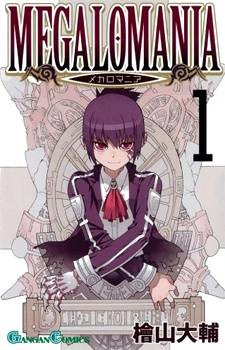I usually like to have some quip about the series here, but the subject matter of Megalomania is a bit on the serious side, so I’m finding it difficult to make one up this time around.
In 2008 while I was working part-time at a comic store in Japan, I happened to notice a manga titled Megalomania (メガロマニア). I was drawn to the series because a friend of mine had been talking about megalomaniac characters in American comics, and I thought maybe the main character in this series would be one as well. However, what I read was a very dark and somewhat depressing story. It’s well written and thoroughly captures the desperation of a group of oppressed people, but the series suffers from one major drawback: it’s too short. This is one instance where I truly believe the publisher, Square-Enix, should have let the series continue, rather than prematurely ending it.
One of the greatest aspects of fiction is its ability to draw parallels from real world and historical events, even though those events are sometimes altered to make for a more compelling story. Feudal Japan is one of the more popular eras explored in Japanese fiction, but Daisuke Hiyama’s series Megalomania seems to draw inspiration from legalized segregation, namely the Jim Crow laws passed after the American Civil War, and I think the author did a good job adapting the mindset of people living though segregation to this story. This makes the material much darker in tone as can be seen when the subject of slums, drugs, and police brutality are brought up. The first volume of the series illustrates this wonderfully when the equivalent of the S.W.A.T summarily executes demi-humans who are part of an extremist wing of the civil rights movement. It really helped to put the story and world into perspective and was a good reference point for the series’ main character, Kanon Passacaglia.
However, it’s the final two volumes where the story really shines. Covering two different story arcs, the author was able to show just how much prejudice humans had towards the demi-humans, the resentment the demi-humans had against a system that oppresses them, and an ever-widening rift between the two groups. The first of the two story arcs deals heavily with issues of unjust imprisonment, using those prisoners for Roman-style Coliseum matches, and with the cost of true freedom. It’s not a pleasant read to say the least, and feels out of place in a shonen series, but I feel it’s important for younger readers to be exposed to subject matters such as this.
The final story arc is an excellent culmination of the themes from the four-volume series. I highly enjoyed reading it, as the tension among a number of different parties was at a breaking point. There are very few shonen series that manage to achieve this level of writing, and it’s quite refreshing. It did seem a bit rushed, though still well thought out, and I would have liked to have seen the tensions extended beyond the one peaceful protest gone riot.
In fact, the length of the series is it’s only weak point. Had the author had more time to expand on what he had, I believe there would have been much more development in not just the story, but with the characters as well. After the final story arc, there is a short epilogue, where it essentially states, “Everything went back to normal,” but it’s obvious something had changed and the world was about to undergo a radical shift in its treatment of demi-humans, for better or for worse. Even the characters undergo a shift in their perceptions of the larger issues at hand. Kanon is exposed to a more unseemly side of the civil rights movement, her partner Johan Bachelbel is confronted with his childhood friend’s seething hatred of demi-humans, and as a reader I was upset the last member of the police-box was never introduced.
I understand from a business perspective it’s not profitable to keep syndicating a series that isn’t too popular—during it’s publication, Megalomania was competing with the rising popularity of Soul Eater and the final story arc of Full Metal Alchemist—but had the editors at Square-Enix let the series run longer, I believe it would have gained popularity as a second tier series. The setting, themes, and main characters all have the makings for an amazing, but somewhat darker, story, and it was a shame the editors wouldn’t let those aspects play out. If I were to speculate about the reasons why the publishers prematurely ended the series, and I will, it’s because the series didn’t feel at all like a typical shonen series: no hot-blooded main character, no simple to follow story, no over-the-top special moves, among other things. There are a handful of anime and manga series similar in story design to Megalomania that have become popular, and I see no reason why the same couldn’t have been true for this series as well.
Megalomania is a wonderful short series that never got to realize it’s full potential. For a shonen series, it does a good job of discussing the very difficult and very real issue of segregation, and the mindset that comes with it. I would love it if Square-Enix brought the series back into syndication, just to see how the world and characters change from the final volume, but I highly doubt this will ever happen. If you’re fed up with many of the common tropes in shonen manga and want to read a series that tackles some tough issues, I would highly recommend reading this series. It may be difficult to find, and I don’t think it has been translated, but if you’re willing to jump through a few hoops to get a hold of it, I think you’ll be satisfied, as I was.
Work Info
Title: Megalomania (メガロマニア)
Under: Shonen Gangan, Square-Enix
Official Site: http://www.square-enix.co.jp/magazine/powered/title/megalomania/
